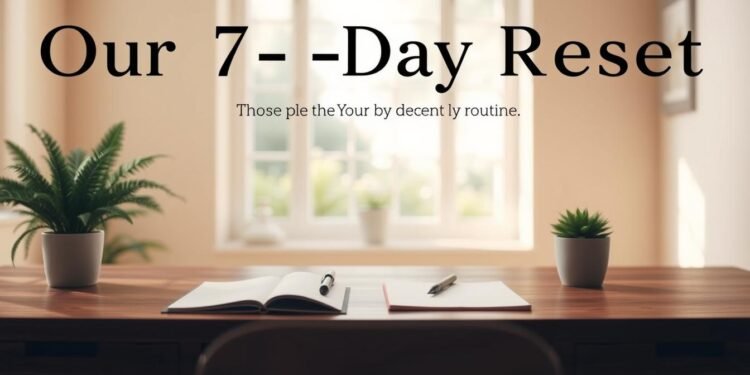Does life feel overwhelming, like you’re constantly juggling tasks without a moment to breathe? You’re not alone. Many of us struggle to maintain mental clarity amidst daily obligations, leaving us feeling drained and unfocused.
This is where a structured approach can make all the difference. By dedicating just one week to a mindful reset, you can declutter your thoughts, establish new habits, and regain control. It’s not about drastic changes but small, intentional steps that add up.
Imagine waking up with a clear mind, ready to tackle the day with purpose. This framework is designed to help you achieve just that. Let’s explore how you can transform your life, one day at a time.
Key Takeaways
- Modern life often leaves us feeling mentally cluttered and overwhelmed.
- A structured reset can help declutter thoughts and improve focus.
- Small, intentional steps lead to lasting habit formation.
- This approach addresses mind, body, and environment holistically.
- Relatable scenarios make the process accessible and practical.
Introduction: Why You Need a 7-Day Reset
Ever feel stuck in a cycle of monotony, where days blur together without progress? This is a common experience in modern life, where mental fog and deferred goals can leave us feeling stagnant. A structured reset can make a significant difference by helping us break free from this cycle.
Signs you might need a reset include constant fatigue, lack of focus, and a sense of being overwhelmed. Temporary fixes, like quick breaks or distractions, rarely address the root cause. Instead, lasting transformation comes from intentional, small steps that build over time.
Neuroscience shows that habit formation takes 21 to 28 days. A reset jumpstarts this process, creating a foundation for sustainable change. Many people report feeling the positive effects weeks or even months later, proving its long-term impact.
Structured approaches also reduce decision fatigue. Studies show that having a clear plan can lower stress and improve focus. By dedicating just one week to a mindful reset, you can reclaim clarity and set the stage for a more fulfilling life.
Day 1: The Life Audit
Starting with a clear picture of where you stand can set the tone for meaningful change. A life audit is a powerful tool to assess your current situation and identify areas for improvement. It’s about taking a step back to evaluate what’s working and what’s not.
We’ll guide you through a 10-point self-assessment scale across key life domains. This includes relationships, career, health, and personal growth. The goal is to create a comprehensive snapshot of your life.
Assessing Your Current Situation
Begin by grabbing a piece of paper and making a list of the most important areas in your life. Rate each domain on a scale of 1 to 10, with 10 being the most fulfilling. This exercise helps you visualize where you’re thriving and where you need attention.
Remember, this is a judgment-free zone. Be honest with yourself without criticism. Psychological safety is crucial for accurate self-assessment.
Identifying Key Areas for Change
Next, use the energy mapping technique to identify activities that drain or energize you. Write down tasks or habits that leave you feeling exhausted and those that bring joy. This helps pinpoint what to eliminate or prioritize.
For example, one case study showed how a quarterly planner used this method to streamline their schedule. By focusing on high-energy activities, they achieved greater productivity and satisfaction.
By the end of the day, you’ll have a clear understanding of your current state and actionable insights for the week ahead. This foundation sets the stage for lasting transformation.
Day 2: Declutter Your Mind & Space
Have you noticed how clutter can weigh down both your space and your thoughts? When our surroundings are chaotic, it often reflects in our mental state. Today, we’ll focus on creating harmony in both areas.

Clearing Mental Clutter
Start with a “brain dump” exercise. Grab a piece paper and set timer for 10 minutes. Write down everything on your mind—tasks, worries, ideas. This technique helps clear mental clutter and provides clarity.
Studies show that writing things down reduces stress and improves focus. It’s a simple yet powerful way to organize your thoughts and prioritize what truly matters.
Resetting Your Physical Environment
Next, tackle your space. Use the 15-minute refresh method. Focus on one area, like your desk or living room, and remove unnecessary things. Organize items into categories: keep, donate, or discard.
Research in spatial psychology reveals that organized spaces reduce cortisol levels and boost productivity. A case study found that participants who decluttered their homes reported feeling calmer and more in control.
For a deeper reset, try the KonMari-inspired flowchart. Ask yourself if each item sparks joy. If not, it’s time to let it go. This method ensures your space reflects your values and supports your goals.
Feeling overwhelmed? Use the 5-4-3-2-1 emergency reset. Identify five things you see, four you can touch, three you hear, two you smell, and one you taste. This grounding technique brings you back to the present moment.
Day 3: Create a Vision for Your Future Self
What does your ideal future look like, and how do you want to feel as you move toward it? Crafting a vision for your future self is a powerful way to align your actions with your deepest desires. It’s not just about setting goals—it’s about imagining how you want to feel and the life you want to lead.
Defining Your Desired Feelings
Start by asking yourself, “How do I want to feel in my ideal future?” This question helps you focus on emotions rather than just outcomes. Use sensory-based visualization techniques to imagine your future self. Close your eyes and picture where you are, what you’re doing, and how it feels. This exercise taps into the neuroscience of visualization, which shows that imagining success can activate the same brain regions as actually achieving it.
Future self journaling is another effective method. Write a letter from your future self to your present self. Describe the life you’ve built and the emotions you experience. This practice helps clarify your vision future and motivates you to take actionable steps.
Gathering Visual Inspiration
Visual tools like mood boards can bring your vision to life. Start by searching for images on Pinterest that resonate with your ideal future. Use keywords like “vision future” or “feel like” to find inspiration. Then, organize these images into a mood board using Canva templates. This process makes your goals tangible and keeps you motivated.
Neuroscience shows that regularly engaging with visual reminders of your goals strengthens neural pathways. This makes it easier to stay focused and take consistent action. By creating a vision for your future self, you’re setting the stage for meaningful and lasting change.
Day 4: Define Your “Feel-Good” Habits
How often do you find yourself caught in the whirlwind of daily tasks, wishing for a moment of peace? Today, we’ll focus on building habits that nurture your body, soul, and spirit. These small, intentional actions can transform your day and set the tone for a more balanced week.
Body: Small Physical Actions
Start with your body. Incorporate micro-habits that take less than two minutes, like stretching or drinking a glass of water. These small actions can have a big impact over time.
Align your habits with your circadian rhythm. Morning light exposure and evening wind-down routines can optimize your energy levels. Consistency is key to making these things stick.
Soul: Moments of Peace
Next, focus on your soul. Create moments of peace through mindfulness or journaling. These practices help you reconnect with yourself and reduce stress.
Try habit-stacking by pairing these moments with existing routines. For example, meditate after brushing your teeth. This makes it easier to integrate into your day.
Spirit: Nurturing Your Inner Self
Finally, nurture your spirit. Engage in activities that bring you joy, like reading or spending time in nature. These actions feed your inner self and keep you grounded.
Use a SMART goal refinement worksheet to track your progress. This helps you stay focused and motivated as you build these habits.
Day 5: Plan Your First Action Step
What if you could achieve meaningful progress in just 20 minutes a day? Today, we’ll focus on turning your goals into actionable steps. By breaking down your plan into small, manageable tasks, you can avoid feeling overwhelmed and start making real progress.

Choosing Your Focus Area
Start by identifying your top priority. Use the Eisenhower Matrix to categorize tasks into urgent, important, and less critical. This helps you focus on what truly matters and avoid wasting time on low-impact activities.
Next, apply the concept of minimum viable progress. Instead of aiming for perfection, focus on taking the smallest possible step forward. This approach reduces pressure and makes it easier to get started.
Defining a 20-Minute First Step
Set a timer for 20 minutes and commit to working on your chosen task. This short time frame helps you overcome procrastination and build momentum. Remember, progress is more important than perfection.
Use tools like Trello or Asana to track your steps. These platforms make it easy to organize tasks, set deadlines, and monitor your progress. By breaking your work into smaller chunks, you’ll stay motivated and focused.
Parkinson’s Law states that work expands to fill the time available. By setting a strict hour limit, you’ll naturally become more efficient and productive. This simple technique can transform how you approach your goals.
Day 6: Take the First Step
Sometimes, the hardest part of change is simply starting. Today, we’ll focus on overcoming that initial hurdle and building momentum. Whether you’re an introvert or extrovert, there’s a strategy that works for you.
Moving in Silence
For some, taking the first step means working quietly and independently. If this resonates with you, try the “momentum creation” concept. Start with a take deep breath and focus on one small task. This approach reduces overwhelm and builds confidence.
Introverts often thrive with tools like focus music playlists or noise-cancelling headphones. These create a distraction-free environment, helping you stay in the zone. Remember, progress doesn’t need an audience—it just needs you.
Seeking Accountability
If you’re someone who benefits from external support, accountability is key. The dual-path accountability model offers flexibility. You can partner with a friend or use habit-tracking apps to monitor your progress.
Consider drafting a partnership contract template. This formalizes your commitment and ensures both parties stay on track. Sharing your goals with someone else can be a powerful motivator.
Don’t fear setbacks. The “failure resume” concept normalizes mistakes and turns them into learning opportunities. By documenting what didn’t work, you’re better prepared for future challenges.
No matter your approach, remember to press the reset button when needed. Progress isn’t linear, and that’s okay. Focus on what you’re going to achieve and let everything else fall into place.
Day 7: Reflect & Celebrate
As we wrap up this transformative week, it’s time to look back and acknowledge how far you’ve come. Reflection and celebration are essential steps in solidifying the progress you’ve made. They help you recognize the difference this journey has brought to your life and set the stage for continued growth.
Structured Reflection with the GROW Model
Start by using the GROW model—Goals, Reality, Options, and Way Forward. This framework helps you assess what you’ve achieved, where you stand, and what steps to take next. Write down your thoughts to create a clear roadmap for your vision future.
The Power of Celebration
Celebrating your achievements isn’t just about feeling good—it’s scientifically beneficial. Dopamine, the “feel-good” hormone, is released when you acknowledge your successes. This boosts motivation and reinforces positive behaviors.
Create a milestone recognition certificate to honor your progress. Document your “lessons learned” to reflect on what worked and what didn’t. This process helps you stay grounded and focused on your goals.
Finally, implement a reward tier system. Break your goals into smaller milestones and assign rewards for each. This keeps you motivated and ensures you continue moving forward, one day at a time.
Conclusion: Building Lasting Momentum
Building lasting momentum requires intentional effort and consistent practice. To maintain the progress you’ve made, consider adopting a 90-day reset cycle. This approach helps you stay aligned with your goals and adapt to changes in your life.
Reinforce your habits through temptation bundling. Pair activities you enjoy with those you find challenging. This technique makes it easier to stick to your way forward and build sustainable routines.
Use a quarterly review checklist to assess your progress. Reflect on what’s working and what needs adjustment. This practice ensures you stay on track and continue moving toward your future vision.
Surround yourself with a supportive community. Share your journey with like-minded individuals who can offer encouragement and accountability. Together, you can take deep steps toward lasting change.
Ready to keep the momentum going? Download our printable reset toolkit to guide your next steps. Let’s continue this journey toward a more balanced and fulfilling life.
FAQ
What is the purpose of this plan?
This plan helps you clear your mind, reset your routine, and create a vision for your ideal future. It’s designed to bring focus and energy to your daily life.
How much time do I need each day?
You’ll need about 20 to 60 minutes daily. The steps are simple and flexible to fit into your schedule.
Do I need any special tools to start?
No special tools are required. Just a piece of paper, a pen, and a quiet space to reflect and plan.
Can I adjust the plan to my needs?
Absolutely. The plan is adaptable. Feel free to tweak it to suit your lifestyle and goals.
What if I miss a day?
That’s okay. Simply pick up where you left off. The plan is about progress, not perfection.
How do I stay motivated throughout the week?
Focus on small wins and celebrate each step. Keeping a journal can also help track your progress and keep you inspired.
What’s the best way to handle mental clutter?
Start by writing down everything on your mind. Then, prioritize and tackle one thing at a time. Deep breaths can also help clear your thoughts.
How do I define my “feel-good” habits?
Think about what makes you feel energized and at peace. These could be simple actions like stretching, meditating, or enjoying a cup of coffee.
What’s the importance of reflecting at the end?
Reflection helps you see how far you’ve come and what you’ve learned. It’s a chance to celebrate your efforts and plan your next steps.



